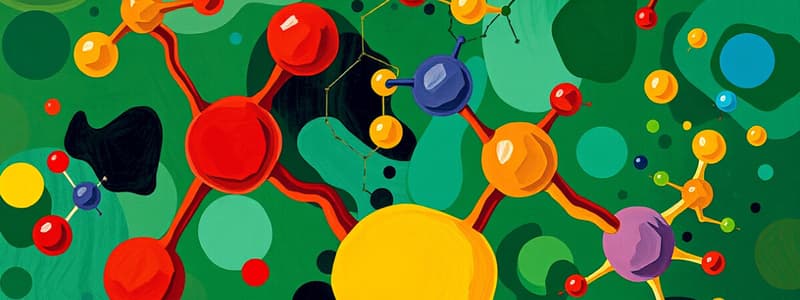Podcast
Questions and Answers
The four main categories of large biological molecules present in living systems are _____
The four main categories of large biological molecules present in living systems are _____
- RNA, DNA, proteins, and carbohydrates
- Proteins, DNA, RNA, and steroids
- Nucleic acids, carbohydrates, monosaccharides, and proteins
- Monosaccharides, lipids, polysaccharides, and proteins
- Proteins, nucleic acids, carbohydrates, and lipids (correct)
The building blocks or monomers of nucleic acid molecules are called _____
The building blocks or monomers of nucleic acid molecules are called _____
- DNA and RNA
- Fatty acids
- Nucleotides (correct)
- Polysaccharides
- Pyrimidines and purines
Starch is composed of ________
Starch is composed of ________
- Branched amylopectin and branched amylose
- Branched amylopectin and unbranched amylose (correct)
- Unbranched amylopectin and unbranched amylose
- Unbranched amylopectin and branched amylose
A dehydration reaction (or condensation reaction) is the process in which _____
A dehydration reaction (or condensation reaction) is the process in which _____
What component of amino acid structure varies among different amino acids?
What component of amino acid structure varies among different amino acids?
The characteristic that all lipids have in common is that _____
The characteristic that all lipids have in common is that _____
Which functional group(s) is (are) present in all amino acids?
Which functional group(s) is (are) present in all amino acids?
What is a macromolecule?
What is a macromolecule?
Define polymer.
Define polymer.
Define monomers.
Define monomers.
What are enzymes?
What are enzymes?
What is a dehydration reaction?
What is a dehydration reaction?
Define hydrolysis.
Define hydrolysis.
What are carbohydrates?
What are carbohydrates?
What are monosaccharides?
What are monosaccharides?
What is a disaccharide?
What is a disaccharide?
What is a glycosidic linkage?
What is a glycosidic linkage?
What are polysaccharides?
What are polysaccharides?
What is starch?
What is starch?
What is glycogen?
What is glycogen?
Define cellulose.
Define cellulose.
What is chitin?
What is chitin?
What are lipids?
What are lipids?
What constitutes a fat?
What constitutes a fat?
Define fatty acid.
Define fatty acid.
What is triacylglycerol?
What is triacylglycerol?
Define saturated fatty acid.
Define saturated fatty acid.
Define unsaturated fatty acid.
Define unsaturated fatty acid.
What are trans fats?
What are trans fats?
What is a phospholipid?
What is a phospholipid?
Define steroids.
Define steroids.
What is cholesterol?
What is cholesterol?
Define gene.
Define gene.
What are nucleic acids?
What are nucleic acids?
What is deoxyribonucleic acid (DNA)?
What is deoxyribonucleic acid (DNA)?
What is ribonucleic acid (RNA)?
What is ribonucleic acid (RNA)?
Define gene expression.
Define gene expression.
What are polynucleotides?
What are polynucleotides?
Define nucleotides.
Define nucleotides.
What is a pyrimidine?
What is a pyrimidine?
What are purines?
What are purines?
Define deoxyribose.
Define deoxyribose.
What is ribose?
What is ribose?
What is a double helix?
What is a double helix?
Define antiparallel.
Define antiparallel.
What is bioinformatics?
What is bioinformatics?
Define genomics.
Define genomics.
What is proteomics?
What is proteomics?
Flashcards are hidden until you start studying
Study Notes
Biological Molecules
- Major categories include proteins, nucleic acids, carbohydrates, and lipids.
- Nucleic acids are formed from monomers called nucleotides, which consist of a nitrogen base, a pentose sugar, and a phosphate group.
Carbohydrates
- Starch is composed of branched amylopectin and unbranched amylose.
- Carbohydrates exist as monosaccharides, disaccharides, and polysaccharides, with monosaccharides being the simplest form.
- Glycosidic linkages join monosaccharides, forming disaccharides and polysaccharides through dehydration reactions.
Amino Acids
- Amino acids consist of an amino group and a carboxyl group, with variability coming from the R group (side chain) of the amino acid.
Lipids
- Characteristic commonality among lipids is their hydrophobic nature; they do not dissolve in water.
- Fats are composed of three fatty acids linked to glycerol, termed triacylglycerols or triglycerides.
- Fatty acids can be saturated (single bonds) or unsaturated (one or more double bonds).
- Phospholipids have hydrophilic heads and hydrophobic tails, important in forming cellular membranes.
Enzymes
- Enzymes are macromolecules that catalyze chemical reactions without being consumed, typically composed of proteins.
Genetic Information
- Nucleic acids include DNA and RNA, which are polymers of nucleotides serving as blueprints for protein synthesis.
- DNA is characterized by its double-helix structure and contains deoxyribose sugar, while RNA includes ribose sugar and typically functions in protein synthesis.
Molecular Structures
- Polynucleotides are formed from nucleotide monomers, and they can be strands of DNA or RNA.
- Antiparallel orientation refers to the opposite directionality of the sugar-phosphate backbone in the DNA double helix.
Biochemical Techniques
- Bioinformatics combines biology, computer science, and mathematics to analyze large biological data.
- Genomics studies entire sets of genes within a species and their interactions.
- Proteomics focuses on the properties, interactions, and abundance of proteins within a biological system.
Studying That Suits You
Use AI to generate personalized quizzes and flashcards to suit your learning preferences.




